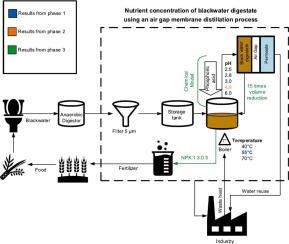利用气隙膜蒸馏工艺浓缩黑水沼渣中的营养物质
IF 6.3
2区 工程技术
Q1 ENGINEERING, CHEMICAL
引用次数: 0
摘要
真空厕所排出的黑水含有大量营养物质,可重新用作肥料。本研究旨在评估一种气隙膜蒸馏工艺,以浓缩黑水沼渣中的营养物质。在第一次实验中,对进料进行了各种温度(40 °C、55 °C和70 °C)和pH值(2.5、2.8、3.0、4.0和6.0)测试,结果在第二次实验中,操作条件为55 °C,pH值为4。在这些条件下,体积减少了 15 倍。在第二次实验中,前 18 小时的平均渗透通量为 1.95 Lm-2 h-1,运行 150 小时后降至 0.81 Lm-2 h-1。当通量降至 0.39 Lm-2 h-1 时,膜被清洗。最终浓缩物的氮磷钾元素重量比为 1:3:0.3。化学模型显示,大部分铵和磷溶解在浓缩物中,一些磷酸盐化合物沉淀下来。产品中含有必需的微量营养元素和较低含量的有害物质,如砷、汞、镉和铅,其中氯化钠的含量为 0.3%。主要的挑战是膜湿润,导致氮损失 33%,磷损失 13%。尽管挑战重重,该工艺还是成功生产出了对农业有益的富营养浓缩物。本文章由计算机程序翻译,如有差异,请以英文原文为准。

Nutrient concentration of blackwater digestate using an air gap membrane distillation process
Blackwater from vacuum toilets contains significant amounts of nutrients that can be repurposed as fertilizer. This study aimed to evaluate an air gap membrane distillation process to concentrate nutrients in blackwater digestate. In the first experiments, various temperatures (40 °C, 55 °C and 70 °C) and pH levels (2.5, 2.8, 3.0, 4.0 and 6.0) were tested on the feed, resulting in operating conditions of 55 °C and pH 4 for the study's second experiment. Under these conditions, a 15-fold volume reduction was achieved. In this second experiment, the average permeate flux was 1.95 Lm−2 h−1 during the first 18 h, decreasing to 0.81 Lm−2 h−1 after 150 h of operation. The membrane was cleaned when the flux dropped to 0.39 Lm−2 h−1. The final concentrate had an NPK elemental weight ratio of 1:3:0.3. A chemical model indicated that most ammonium and phosphorus were dissolved in the concentrate, with some phosphate compounds precipitating. The product contained essential micronutrients and low levels of harmful substances like As, Hg, Cd, and Pb, with NaCl at 0.3 % of the weight. The main challenge was membrane wetting, leading to 33 % of nitrogen loss and 13 % of phosphorus loss. Despite the challenges the process successfully produced a nutrient-rich concentrate beneficial for agriculture.
求助全文
通过发布文献求助,成功后即可免费获取论文全文。
去求助
来源期刊

Journal of water process engineering
Biochemistry, Genetics and Molecular Biology-Biotechnology
CiteScore
10.70
自引率
8.60%
发文量
846
审稿时长
24 days
期刊介绍:
The Journal of Water Process Engineering aims to publish refereed, high-quality research papers with significant novelty and impact in all areas of the engineering of water and wastewater processing . Papers on advanced and novel treatment processes and technologies are particularly welcome. The Journal considers papers in areas such as nanotechnology and biotechnology applications in water, novel oxidation and separation processes, membrane processes (except those for desalination) , catalytic processes for the removal of water contaminants, sustainable processes, water reuse and recycling, water use and wastewater minimization, integrated/hybrid technology, process modeling of water treatment and novel treatment processes. Submissions on the subject of adsorbents, including standard measurements of adsorption kinetics and equilibrium will only be considered if there is a genuine case for novelty and contribution, for example highly novel, sustainable adsorbents and their use: papers on activated carbon-type materials derived from natural matter, or surfactant-modified clays and related minerals, would not fulfil this criterion. The Journal particularly welcomes contributions involving environmentally, economically and socially sustainable technology for water treatment, including those which are energy-efficient, with minimal or no chemical consumption, and capable of water recycling and reuse that minimizes the direct disposal of wastewater to the aquatic environment. Papers that describe novel ideas for solving issues related to water quality and availability are also welcome, as are those that show the transfer of techniques from other disciplines. The Journal will consider papers dealing with processes for various water matrices including drinking water (except desalination), domestic, urban and industrial wastewaters, in addition to their residues. It is expected that the journal will be of particular relevance to chemical and process engineers working in the field. The Journal welcomes Full Text papers, Short Communications, State-of-the-Art Reviews and Letters to Editors and Case Studies
 求助内容:
求助内容: 应助结果提醒方式:
应助结果提醒方式:


